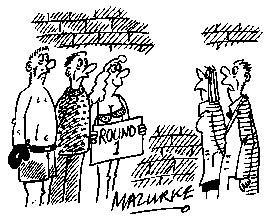Taxi touts outside greeted me with a hopeful ‘Bula’. Mynah birds squabbled in the jacarandas and teenagers on the nearby parkland were throwing long passes with a rugby ball. Not quite your average UK betting-shop setting, but this was the Fiji branch of Grants Waterhouse. I had stepped in seeking a little inspiration for the talk I was to deliver the next day to the Cunard liner Queen Victoria’s passengers on the joys of horse-racing. (It’s a tough assignment, but somebody has to do it.) And, given Mrs Oakley’s developing taste on board for Pina Coladas and White Ladies, a little profit would have done no harm.
The heavy-duty grilles separating the staff from customers could have had a previous life housing inmates at Alcatraz and the fittings were on the economical side of sparse. Warning notices admonished patrons ‘Don’t borrow to bet. Don’t chase losses’. But with race listings from Sydney, Melbourne, Brisbane and Adelaide on the walls, there was no shortage of betting opportunities. One local sought my opinion — rashly since I know little more about Australian racing than the names of a few Melbourne Cup winners and top jockeys like Hugh Bowman, Blake Shinn and Nash Rawiller. He persisted, so I tossed up between suggesting cross doubles on the mounts of Kerrin McEvoy, who rode so well in Britain when he was No. 2 to Frankie Dettori at Godolphin, and Corey Brown.
I went for Corey Brown not because, like our own inimitable Kieren Fallon, he tends to get himself in the headlines (heavy type greeted his six-month suspension for testing positive for cocaine in Hong Kong and there was a fuss over him posing nude on a mechanical horse for a charity calendar) but because I had noted he was leading the Sydney jockeys’ championship.
When I checked the results on arrival in New Zealand three days later, I was pleased to see that at Randwick-Kensington that day C.W. Brown was credited with three winners. We had sailed out of Lautoka uplifted by a gloriously uninhibited toe-tapping musical send-off from the Fiji Police Band — old traditions linger — and it was nice to feel that I left one Fijian citizen a little richer than when we landed.
To aid my researches I have with me en route to Sydney details of the latest effort from ‘Racing For Change’ to smarten up the sport’s image at home. It includes some sensible suggestions like trialling decimal odds. Those of us used to reckoning up our trebles at odds of 9–4, 15–8 and 100–30 have to accept that in the mobile phone-cum-camera-cum-calculator age we are historical relics. And who ever sees odds of 100–8 any more anyway?
I applaud, too, the plan to finance media training for jockeys and trainers. Every sport has to sell itself now. And it is certainly time for photo finishes to be displayed to racegoers on big screens. Disputed tries and lbw decisions are flashed up at rugby and cricket grounds and that is the least response racing can make. Sound, too, is the plan to create a ‘racing club’ for young adults with discounted admission charges.
But more is needed. The occasional racegoers among my fellow passengers deeply resent racecourses where they are asked to pay parking charges on top of their entrance fee. The regulars argue that all racecourse bookmakers should be forced to offer each-way betting on the same terms. And both categories insist that tracks have got to start providing decent middle-ground catering at reasonable prices for families on an outing — something between the gulls’-eggs and smoked-salmon dining for the nobs and the greasy burger, which often seems to be the only alternative.
One other good suggestion came from the twice-a-year racegoer who complained that when she watches racing on television she is given useful information about the horses stepping round the parade ring but that when she is on course nobody tells her anything.
My own feeling is that we have to look also at the whole structure of the racing calendar on the Flat. Jump racing’s season is a steady build-up to Cheltenham with an extra fillip after that from Aintree’s Grand National meeting. On the Flat, four of the five classics have been run by the end of the first week in June, with another five months of the season to go. Certainly the need for a more co-ordinated presentation is crucial. Last year, as Sea The Stars triumphed in six races, we saw one of the greatest superstars racing has ever had. But was that used in any way to promote the interests of the sport? If it was, I missed it.






Comments